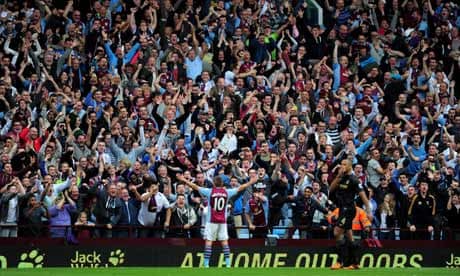The announcement from Celtic that they plan to introduce a safe-standing section at Parkhead leaves a question for the English authorities that hopefully they can absorb with a clear appreciation that it should not be wrong, however difficult a subject it might be, to want football to change for the better.
Plainly, Celtic have noted what happens in the Bundesliga and the likelihood is that more clubs will follow bearing in mind the Scottish Premier League relaxed its rules almost two years ago. But if safe-standing is allowed in other countries, most notably Germany but also the United States, Canada, Sweden and Austria, it does raise the question: why not England? Or, at the very least, why is it so difficult to get a proper, grown-up debate going?
There is certainly an appetite for one, bearing in mind six Premier League clubs – Aston Villa, Cardiff, Sunderland, Crystal Palace, Swansea and Hull – have given their official backing to the Football Supporters' Federation's safe-standing campaign. More than two-thirds of the Football League's 72 clubs voted in favour of trials at its annual conference in June and, before that, 21 of the 22 chief executives present at a meeting of Championship clubs did likewise. David Gold, West Ham's co-owner, has given it his support and, putting the question to the other top-division clubs over the past few days, the clear majority appear to want the debate.
Arsenal's official position is they are "open to dialogue and discussion on the matter", while their chief executive, Ivan Gazidis, is on record saying: "Why would you be against it, if you can do it safely?" Tottenham, Stoke and West Brom are among the clubs who have an "open mind" or are "monitoring" developments. Manchester City are the same. Newcastle are receptive to the idea and plan to discuss it at a fans' forum in December. Fulham are "supportive" depending on certain conditions, primarily that the government makes the first move.
That is anything but straightforward. Standing at football is always going to be a complex, emotive issue bearing in mind the reason why the Taylor Report was commissioned in the first place and, as more than one club have pointed out, it is never going to be an easy subject for this government, or maybe even the next one, when the truth – the real truth – about Hillsborough is still being uncovered in all its horror.
Liverpool's position, in line with the Hillsborough Family Support Group, is firmly in support of all-seater stadiums and, plainly, the other clubs have to bear that in mind and understand the sensitivities. Nobody wants to come across as unaware or lacking tact or empathy. One of the more interesting developments of the past few days has been finding out at least two other clubs believe there should be standing areas. They just don't think it appropriate to say so publicly. Not yet, anyway.
The point is there is a wider debate. There has to be when Professor Steve Frosdick, a founder member of the Football Safety Officers' Association, has said that the FSF has "an irrefutable case" and Jim Chalmers, president of the same organisation, says "all that is necessary to give the fans what they want is a bold step and a leap of faith by government".
Then consider, for what it's worth, the number of politicians, among them Kenneth Clarke and Tony Blair (as shadow home secretary), who have said something similar. Others have tabled early-day motions. Kate Hoey says that when she was sports minister she was "convinced safe-standing should be allowed".
A lot of it is about education. The problem discussing this issue is that too many people are fixed with the mistaken belief that standing cannot be safe. Raise the subject in football circles and, sooner or later, someone will invariably point out a reason why it shouldn't happen. Almost always, however, it is based on a lack of understanding of the facts.
Nobody is calling for a return to the vast, sweeping terraces of old. There is absolutely nothing to show standing is directly linked to hooliganism, and it is one of the myths of Hillsborough that it caused the disaster. A lot has changed since the Taylor Report, that's all.
At Borussia Dortmund there are rail-seats, with a safety barrier on each row and a seat that can be locked in an upright position to leave standing space. At Hamburg the seats can be folded away beneath metal steps. Bochum have a system whereby they can be clipped on or off. In all three cases, the seats can easily be reintroduced for Uefa-regulated fixtures, which stipulate no standing. But for the Bundesliga – or in Bochum's case, Bundesliga 2 – it means a choice, as well as lower ticket prices in the standing areas and, for the most part, a more vibrant atmosphere. This, more than anything, is what has caught Celtic's attention. "Some of the systems that are deployed in Germany and other countries, it's now time to give them a try," their chief executive, Peter Lawwell, says. Supporters who would prefer to sit can continue to do so. They just won't have to worry about their view being blocked.
This is the irony of what we currently have in England. The Taylor Report suggested that fans would get used to sitting down but, nearly a quarter of a century on, that is clearly not the case when every week thousands of supporters are on their feet in front of their seats. It breaches safety regulations and, in a lot of cases, leads to away-fan allocations being cut. But it generally makes no difference. As the FSF states, this is surely "less safe than standing in modern areas properly designed for the job".
The FSF has certainly explored it in great detail. A large-scale survey in 2012 revealed 92% of fans wanted a choice between sitting and standing. In 2009, it was 90%, with just over half saying they preferred to stand. "We do our best to reflect fans' opinion and the issue of standing at football – or rather the lack of it – comes up more than any other," the organisation says. The cost of tickets, presumably, is not too far down the list. The two go hand in hand.
What the campaign lacks, perhaps, is the backing of one of the more influential clubs. Manchester United oppose safe-standing, but simply on the basis it would mean redeveloping existing seating areas at Old Trafford (various football-ground architects, incidentally, say it would not be a huge job). Chelsea believe it will be such a long time before the government agrees to change the legislation that, for now, it is not something the club are considering. Everton are similar, while Norwich and Southampton decided not to make an official comment.
The bottom line, however, is there are far more clubs wanting to emulate the Bundesliga model, or at least have a proper discussion on the subject, than not. So why are they being ignored? Maybe these clubs are wrong and it can be explained to them why. But there is also plenty of compelling evidence to show that modern technology means safe-standing is precisely that: safe. That, surely, is a good starting place.
Steele's role in De Gea's transformation should not be overlooked
Paul Gascoigne tells a story, from happier days, about Mirandinha's time at Newcastle United and how he helped the Brazilian pick up the language. Mostly, it was just a few stock phrases. But Mirandinha was keen to learn. In one of his first games the opposition centre-half hacked him down and, as he rolled around in agony, the bucket-and-sponge man ran over and asked him where it hurt. Mirandinha, as Gazza proudly recalls, politely offered his hand. "Very pleased to meet you," he said.
The story came to mind reading Eric Steele's comments about David de Gea's initial problems settling into English football and the observation that the young Spaniard did not seem to appreciate fully the importance of learning the language. Steele, previously United's goalkeeping coach, ended up taking Spanish lessons to compensate. "David is lazy in his desire to learn English. So I learned. I kept telling him to work on his English."
Steele talks about De Gea "training poorly", having a bad diet and a "horrendous" first six months, and it is unusual to see someone in football talking with such frankness. Please, though, don't mistake this for an attack on the player. Quite the opposite. Steele's interview with United We Stand fanzine is exceptionally candid, but they are the words of a man who has played a key, almost paternal, role in De Gea's improvement.
In the same interview, Steele explains the painstaking process of trying to locate a successor for Edwin van der Sar. "I did more miles than Richard Branson as we looked for a replacement. I watched how they warmed up before games and how they communicated. [Maarten] Stekelenburg at Ajax, [Hugo] Lloris at Lyon, [Manuel] Neuer at Schalke. Very few Germans leave Germany because they know the national team prefer players based in Germany. [Iker] Casillas, Joe Hart, Petr Cech – the ones who would have been very difficult to get. I watched them all." Diego Lopez, now at Real Madrid, also gets a mention, going back to his days at Villarreal.
That is some list and it says a lot for De Gea – "this matchstick of a goalkeeper," as Steele recalls from watching Spain's under-17s – that Steele and Sir Alex Ferguson decided he was the best option. He had a horrendous introduction, as Steele says, but there is plenty to admire about how De Gea has turned it around and the way opponents now see him as one of United's strengths rather than weaknesses. He does, however, need to keep off the tacos.
Time for England to show some faith in Ravel Morrison
Gareth Southgate names his England Under-21 squad on Thursday for the European Championship qualifiers against San Marino and Lithuania and let's hope there is a place for Ravel Morrison now he is keeping our attention because of what he does on the pitch, rather than off it.
Morrison is still a work in progress but his form for West Ham this season lives up to the message he posted a while back on a Twitter account that, at other times, has done him few favours. "I am a changed man," he wrote. "Don't judge me on my past. Respect me for who I am and how I've developed."
Roy Hodgson left him out when he took charge of the Under-21s for the game against Scotland in August and seemed nonplussed at the next press conference when I asked why. "That's a good question," he replied. "How old is he?"
The answer is 20, young enough to make mistakes and old enough, hopefully, to learn from them. At that age, Morrison can still turn out to be the player English football wants him to be.

